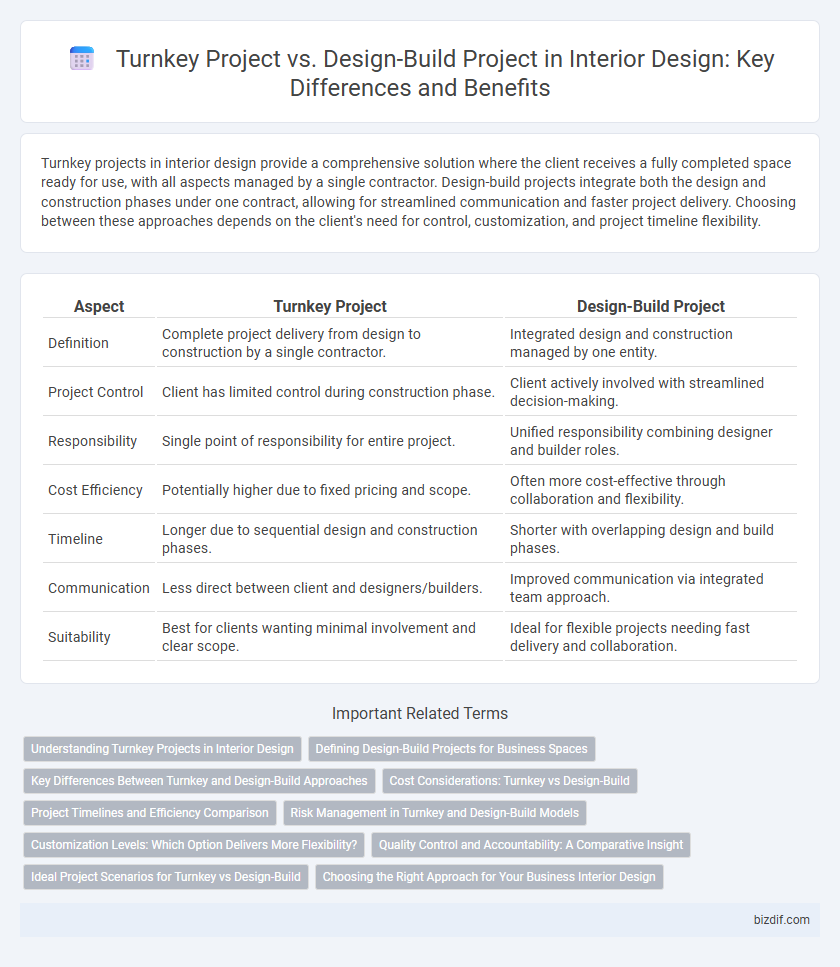Turnkey projects in interior design provide a comprehensive solution where the client receives a fully completed space ready for use, with all aspects managed by a single contractor. Design-build projects integrate both the design and construction phases under one contract, allowing for streamlined communication and faster project delivery. Choosing between these approaches depends on the client's need for control, customization, and project timeline flexibility.
Table of Comparison
| Aspect | Turnkey Project | Design-Build Project |
|---|---|---|
| Definition | Complete project delivery from design to construction by a single contractor. | Integrated design and construction managed by one entity. |
| Project Control | Client has limited control during construction phase. | Client actively involved with streamlined decision-making. |
| Responsibility | Single point of responsibility for entire project. | Unified responsibility combining designer and builder roles. |
| Cost Efficiency | Potentially higher due to fixed pricing and scope. | Often more cost-effective through collaboration and flexibility. |
| Timeline | Longer due to sequential design and construction phases. | Shorter with overlapping design and build phases. |
| Communication | Less direct between client and designers/builders. | Improved communication via integrated team approach. |
| Suitability | Best for clients wanting minimal involvement and clear scope. | Ideal for flexible projects needing fast delivery and collaboration. |
Understanding Turnkey Projects in Interior Design
Turnkey projects in interior design involve delivering a fully completed space where the client receives a ready-to-use environment without managing individual phases. This approach streamlines coordination by consolidating design, procurement, and construction under a single contract, ensuring consistent quality and timeline adherence. Turnkey solutions often appeal to clients prioritizing convenience and risk minimization in project execution.
Defining Design-Build Projects for Business Spaces
Design-build projects for business spaces integrate architectural design and construction services into a single contract, streamlining communication and accelerating project timelines. This approach ensures cohesive collaboration between designers and contractors, reducing errors and costly change orders during the build phase. Turnkey projects, by contrast, deliver the fully finished space ready for immediate use, but often separate design and construction responsibilities, which may extend project duration and complicate coordination.
Key Differences Between Turnkey and Design-Build Approaches
Turnkey projects deliver a fully completed interior design solution where the client receives the space ready for immediate use, ensuring streamlined project management under a single contractor. Design-build projects integrate both design and construction phases but may allow for more client involvement during the design process, promoting flexibility and collaboration. The primary distinction lies in turnkey's fixed scope and faster delivery versus design-build's iterative approach tailored to evolving client needs in interior design.
Cost Considerations: Turnkey vs Design-Build
Turnkey projects often involve a fixed budget determined before construction begins, reducing the risk of cost overruns by providing a single point of financial accountability. Design-build projects can offer more flexible budgeting by integrating design and construction phases, allowing for adjustments that may optimize expenses throughout the project. Cost considerations in both approaches depend on project complexity, timelines, and level of client involvement, with turnkey often favored for strict budget control and design-build for potential cost savings through collaboration.
Project Timelines and Efficiency Comparison
Turnkey projects in interior design offer streamlined timelines by delivering fully completed spaces ready for immediate use, minimizing client involvement and accelerating project completion. Design-build projects integrate design and construction phases under one contract, enhancing communication and reducing delays but requiring more client engagement throughout the process. Efficiency in turnkey projects centers on rapid delivery with less flexibility, while design-build projects optimize timelines through collaborative workflows, balancing speed with customization.
Risk Management in Turnkey and Design-Build Models
Turnkey projects centralize risk by assigning a single contractor responsibility for design and construction, minimizing client exposure to cost overruns and delays. Design-build models share risks between the client and contractor, fostering collaboration but requiring clear contract terms to manage accountability. Effective risk management in both models hinges on precise scope definition, transparent communication, and comprehensive contingency planning.
Customization Levels: Which Option Delivers More Flexibility?
Turnkey projects offer limited customization due to predefined scopes and faster delivery timelines, making them suitable for clients prioritizing efficiency over flexibility. Design-build projects provide higher customization levels by integrating design and construction phases, allowing continuous client input and tailored solutions throughout the process. Clients seeking extensive personalization and adaptability often benefit more from design-build projects in interior design.
Quality Control and Accountability: A Comparative Insight
Turnkey projects offer a streamlined approach with a single contractor overseeing both design and construction, ensuring consistent quality control and clear accountability throughout the process. In contrast, design-build projects integrate design and construction teams early, fostering collaboration that can enhance quality management but may complicate pinpointing accountability. Both methods emphasize quality control, but turnkey projects provide more straightforward responsibility, whereas design-build projects rely on close coordination for optimal outcomes.
Ideal Project Scenarios for Turnkey vs Design-Build
Turnkey projects are ideal for clients seeking a streamlined process with a single point of accountability, making them perfect for commercial interiors with fixed budgets and tight timelines. Design-build projects suit complex residential or custom commercial spaces requiring greater collaboration between designers and contractors to integrate innovative solutions and adjust scope dynamically. Selecting between these approaches depends on the project's complexity, budget flexibility, and client involvement preferences to ensure efficient delivery and design quality.
Choosing the Right Approach for Your Business Interior Design
Turnkey projects deliver fully completed interior design solutions where the contractor manages all phases from concept to execution, ideal for businesses seeking a hassle-free process with a fixed timeline and budget. Design-build projects integrate design and construction teams, fostering collaboration that can reduce costs and speed up delivery while allowing more flexibility in design adjustments. Selecting the right approach depends on your business priorities for control, budget certainty, and timeline, with turnkey suited for streamlined delivery and design-build offering adaptability and creative input.
Turnkey project vs Design-build project Infographic

 bizdif.com
bizdif.com